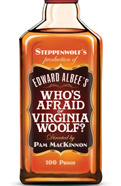Director Pam MacKinnon on Why Who's Afraid of Virginia Woolf? Is Like Mountain Climbing
About the author:
After making her Broadway directorial debut with the 2012 Tony-winning play Clybourne Park, Pam MacKinnon is back with a vengeance. The director, whose sizzling Steppenwolf Theatre Company production of Edward Albee's Who’s Afraid of Virginia Woolf? earned rave reviews in Chicago and Washington, D.C., opened the acclaimed production at Broadway’s Booth Theatre on October 13, just in time for the play’s 50th anniversary. Although she's still relatively new on the Broadway scene, MacKinnon is no stranger to Albee’s works, having previously directed The Goat, or Who Is Sylvia?, The Play About the Baby, At Home at the Zoo, Occupant and more. Below, MacKinnon shares her experiences of tackling Albee’s modern masterpiece, working with Steppenwolf standouts Amy Morton and Tracy Letts and climbing this “mountain of a play” as a company.
![]()
Edward Albee’s Who’s Afraid of Virginia Woolf? is a mountain of a play, a classic that remains absolutely current. There are huge audience expectations. People remember lines, know the movie, saw Uta [Hagen] and Arthur [Hill], saw Bill [Irwin] and Kathleen [Turner], performed it themselves in college, listened the LP as kids. Every night at the Booth Theater I am told personal stories from strangers, who feel ownership. I am also told, frequently by the same people, that the cast and I have somehow reinvented the play. This was never our intent per se. I wanted to obey its huge range, emotional and tonal, and dig deep into these roles.
This range is everywhere, like the absurd moment when George returns, having left in a huff to let Martha tell “the boxing story” an example of how George has let them down, with what looks like a shotgun. He points it at Martha’s head. Honey screams. George pulls the trigger. Out comes a red and white umbrella. “Pow! You’re dead. Pow! You’re dead.” It’s certainly the biggest laugh among the four characters and also the biggest laugh for the audience. It’s silly. It releases wonderful tension. Martha is impressed. She wants a kiss, which George then manipulates to shame her in front the guests. Then Martha ups the ante and blatantly flirts with Nick. “You don’t need any props. Do you, baby?” All this in less than 90 seconds of stage time.
Similarly, deep in the harrowing third act. Martha has dropped to the floor upon learning that their son is dead, and George “makes a joke” answering Martha’s demand that he show her the telegram announcing Sunny Jim’s demise with the quip “I ate it.” The audience laughs. Martha is far from amused. Nick is shocked that George would say such a thing. “I. ATE. IT.” George repeats. Martha then spits in his face. The audience gasps. All this is less than 30 seconds.
Or how about titular song, “Who’s Afraid of Virginia Woolf?” four times sung to the Disney tune, invoking the three little pigs? It’s sung once to cheer up, once to shame, once to divert attention from, once to soothe and as the lights fade, Martha answers rhetorical question. “I am, George. I am.” The song has gone on a huge journey, like the characters, and hopefully like the audience.
I think of Edward’s play as fractals: the small moments reveal the whole and vice versa; there is a same-similar geometry to be obeyed. Every beat bundles tragedy with comedy. George and Martha are too smart to wallow, too smart to stay angry, too resilient not to fight back with glee for much of the play. To this end my central mission in this production was to make sure that the love between George and Martha is palpable. I wanted their eventual hurtfulness to be all the more distressing because we know what is underneath. The vast majority of act one is light, easy, known repartee. There’s a lot of laughter, on and off stage. Small strains are felt but patched over. It is titled “Fun and Games” after all, and I took that to heart, encouraging Amy Morton and Tracy Letts, my Martha and George, to play for each other and reward each other, and it’s only through the accumulation of these slights and public hits and humiliations do George and Martha pledge all out war.
It’s as if the younger couple, with their lack of empathy toward one another and their dysfunction, gradually infects their hosts, pushing them new brutal extremes. George is not wrong at all by the end of the night that “it was time” to stop their hurtful games, triangulating their relationship through others, including their son, but I wanted it clear that they love and respect each other’s personhood and minds both with what they can say to each, how they listen, how they look at each other, this in sharp contrast to Nick and Honey. It does feel like a new play, perhaps, because we never approached it as iconic, and the cast is giving hugely of themselves. I believe we are doing what Edward wrote.
I am very fortunate that this is the sixth Albee play that I have directed and my ninth production over 11 years. I am blessed with a fantastic cast of Amy Morton, Tracy Letts, Madison Dirks and Carrie Coon, who can be as honest and daring as any group of actors I’ve worked with, while also being intellectually rigorous and truly hilarious. I’m also working with a top-drawer team of designers, who honor Edward’s realism, digging deep into place, character and period. We keep surprising each other, night after night. Edward asked the company after our fifth preview, if we were having fun yet. I know I am. Mountain climbing can be great fun.

